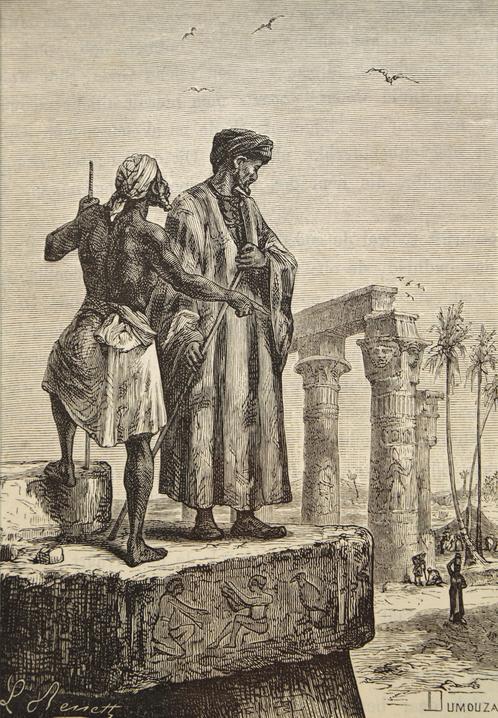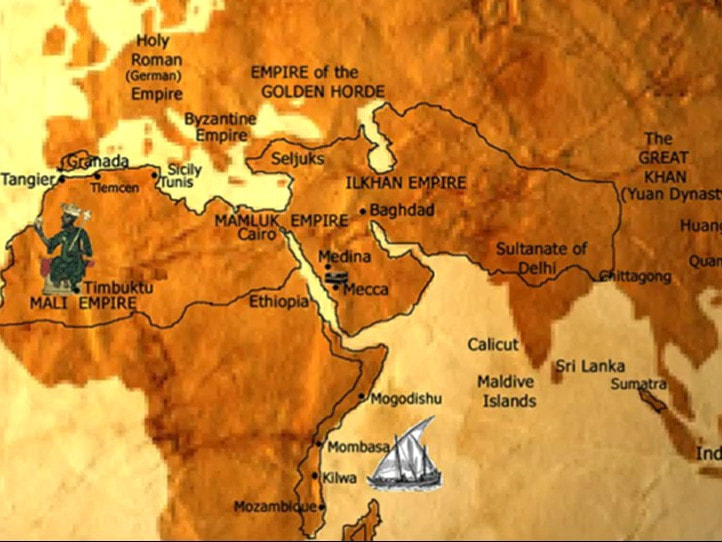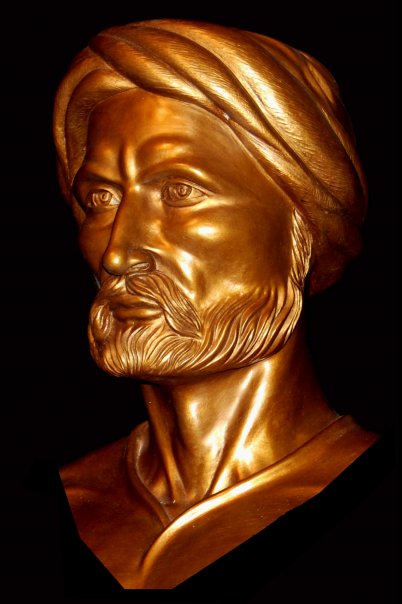Greatest African Travelers
Ibn Battuta: Travels in Asia and Africa 1325-1354
|
Ibn Battuta started on his travels when he was 20 years old in 1325. His main reason to travel was to go on a Hajj, or a Pilgrimage to Mecca, as all good Muslims want to do. But his traveling went on for about 29 years and he covered about 75,000 miles visiting the equivalent of 44 modern countries which were then mostly under the governments of Muslim leaders of the World of Islam, or "Dar al-Islam".
Near the end of Ibn Battuta's own life, the Sultan of Morocco insisted that Ibn Battuta dictate the story of his travels to a scholar and today we can read translations of that story called "Rihla - My Travels". Much of it is fascinating, but some of it seems to be made up and even is inaccurate about places we know about. However, it is a valuable and interesting record of places which add to our understanding of the Middle Ages. http://www.indiana.edu/~dmdhist/ibnbattuta.htm (This page also contains some quotes from his writings.) Ibn Battuta (or Ibn Baṭūṭah) (/ˌɪbənbætˈtuːtɑː/; Arabic: محمد ابن بطوطة; fully ʾAbū ʿAbd al-Lāh Muḥammad ibn ʿAbd al-Lāh l-Lawātī ṭ-Ṭanǧī ibn Baṭūṭah; Arabic: أبو عبد الله محمد بن عبد الله اللواتي الطنجي بن بطوطة) (February 25, 1304 – 1368 or 1369) was a Berber Muslim Moroccan scholar and explorer who widely travelled the medieval world. Over a period of thirty years, Ibn Battuta visited most of the Islamic world and many non-Muslim lands, including North Africa, the Horn of Africa, West Africa, the Middle East, Central Asia, Southeast Asia, South Asia and China. Near the end of his life, he dictated an account of his journeys, titled A Gift to Those Who Contemplate the Wonders of Cities and the Marvels of Travelling. https://en.wikipedia.org/wiki/Ibn_Battuta The Moroccan traveler Ibn Battuta is known as the greatest traveller of premodern times. He lived in the 8th century H/14th century CE. Leaving his homeland at the age of 21 to make the holy pilgrimage to Mecca, he performed a series of extraordinary journeys that spanned nearly three decades and took him as far away as India and China, but also to the Volga River valley and south to Tanzania. The narrative of his travels is a unique account on Islamic and medieval history that was placed by the historians within the rich, trans-hemispheric cultural setting of the history of the medieval world. http://www.muslimheritage.com/article/ibn-battuta https://orias.berkeley.edu/resources-teachers/travels-ibn-battuta https://www.khanacademy.org/partner-content/big-history-project/expansion-interconnection/exploration-interconnection/a/ibn-battuta |
Abd al-Rahman b. Muhammad Ibn Khaldun
|
(1332 - 1406 A.C.E. / 732 - 808 A.H.) For Ibn Khaldun, history is a constantly changing cycle, with essentially two groups of people, nomads and townspeople, with peasants in between. He characterizes each group: Nomads are rough, savage and uncultured, and their presence is always inimical to civilization; however, they are hardy, frugal, uncorrupt in morals, freedom-loving and self-reliant, and so make excellent fighters. In addition, they have a strong sense of ‘asabiya, which can be translated as ‘group cohesion’ or ‘social solidarity’. This greatly enhances their military potential. Towns, by contrast, are the seats of the crafts, the sciences, the arts and culture. Yet luxury corrupts them, and as a result they become a liability to the state, like women and children who need to be protected. Solidarity is completely relaxed and the arts of defending oneself and of attacking the enemy are forgotten, so they are no match for conquering nomads. [34] http://www.cis-ca.org/voices/k/khaldun_mn.htm Full text of "Ibn Khaldun's Historiography" https://archive.org/stream/IbnKhaldunsHistoryalMuqaddimah/Ibn%20khaldun%27s%20History%20(al-muqaddimah)_djvu.txt Also see: https://www.byv.org.tr/wp-content/uploads/2012/12/ibn-haldun-okuma.pdf And: http://www.arabislamicscience.ugent.be/wp-content/uploads/2014/12/Muqaddima-English.pdf |
Joannes Leo Africanus
Joannes Leo Africanus, (c. 1494 – c. 1554?) (born al-Hasan ibn Muhammad al-Wazzan al-Fasi, Arabic: حسن ابن محمد الوزان الفاسي) was a Berber[2] Andalusi diplomat and author who is best known for his book Descrittione dell’Africa (Description of Africa) centered on the geography of the Maghreb and Nile Valley. The book was regarded among his scholarly peers in Europe as the most authoritative treatise on the subject until the modern exploration of Africa.[3] For this work, Leo became a household name among European geographers.
https://en.wikipedia.org/wiki/Leo_Africanus
To read his book: https://archive.org/details/historyanddescr01unkngoog/page/n7
http://www.leoafricanus.com/pictures/bibliography/Masonen/Masonen.pdf
Moore: Travels to the Inland Parts of Africa…
https://dl.wdl.org/650/service/650.pdf
https://www.scribd.com/book/182568290/Trickster-Travels-A-Sixteenth-Century-Muslim-Between-Worlds
https://en.wikipedia.org/wiki/Leo_Africanus
To read his book: https://archive.org/details/historyanddescr01unkngoog/page/n7
http://www.leoafricanus.com/pictures/bibliography/Masonen/Masonen.pdf
Moore: Travels to the Inland Parts of Africa…
https://dl.wdl.org/650/service/650.pdf
https://www.scribd.com/book/182568290/Trickster-Travels-A-Sixteenth-Century-Muslim-Between-Worlds
Proudly powered by Weebly


